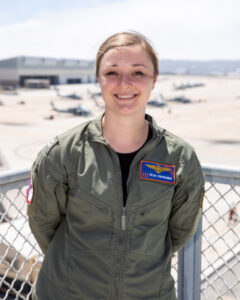By Mass Communication Specialist 1st Class Josiah Trombley, Navy Office of Community Outreach, SAN DIEGO, CA.
Lt. Taylor Forchhammer, a native of White Plains, Maryland, supports versatile missions while serving at Helicopter Sea Combat Squadron (HSC) 3.
Forchhammer joined the Navy 10 years ago. Today, Forchhammer serves as a naval aviator.
“I joined the Navy because I wanted the opportunity to explore the world and break the habits of small-town culture,” said Forchhammer.
Forchhammer attended Henry E. Lackey High School and graduated in 2013.
Skills and values similar to those found in White Plains are similar to those required to succeed in the military.
“My hometown taught me a lot about diversity, exploring my options outside of what’s around me and seeking opportunities,” said Forchhammer. “I learned a lot of this from unique opportunities offered in extracurricular activities. Opportunities aren’t just going to flow your way. You’re going to have to search for them. No one is a better advocate for you than yourself.”
These lessons have helped Forchhammer while serving with the Navy.
Members of HSC 3 fly and maintain helicopters for the U.S. Navy. Navy helicopters are able to perform many different missions. In general, some of the most common operations include search and rescue, air assaults, medical evacuations, supply transport and hunting submarines.
This year commemorates 50 years of women flying in the U.S. Navy. In 1973, the first eight women began flight school in Pensacola; one year later six of them, known as “The First Six,” earned their “Wings of Gold.” Over the past 50 years, the Navy has expanded its roles for women to lead and serve globally and today our women aviators project power from the sea in every type of Navy, Marine Corps, and Coast Guard aircraft. Our Nation and our Navy are stronger because of their service.
As a member of the Navy, Forchhammer is part of a world-class organization focused on maintaining maritime dominance, strengthening partnerships, increasing competitive warfighting capabilities and sustaining combat-ready forces in support of the National Defense Strategy.
“The Navy is important to national defense because we’re the world’s greatest global force for good,” said Forchhammer. “Just because you’re not surrounded by water doesn’t mean that it’s not a vast part of the world. What we do globally helps us to look strong as a nation. We are also more versatile as a Navy. We do so many diverse missions, such as humanitarian efforts.”
With 90 percent of global commerce traveling by sea and access to the internet relying on the security of undersea fiber optic cables, Navy officials continue to emphasize that the prosperity of the United States is directly linked to trained sailors and a strong Navy.
Forchhammer and the sailors they serve with have many opportunities to achieve accomplishments during their military service.
“My proudest accomplishment in the Navy is balancing motherhood with being a lethal military professional,” said Forchhammer. “Before having my son, earning my “wings of gold” was the most challenging goal in my life. But being responsible for another person and having a husband who is deployable, has given me tenacity and grit, which has made me a more compassionate officer.”
As Forchhammer and other sailors continue to train and perform missions, they take pride in serving their country in the United States Navy.
“Serving in the Navy means worldwide opportunities to support democracy, freedom and well-being for all,” said Forchhammer.
Forchhammer is grateful to others for helping make a Navy career possible.
“I would like to thank my parents and my husband for their endless support in all of my dreams in all the good times and the bad,” added Forchhammer. “I would also like to thank my educators who influenced my passion to learn.”




